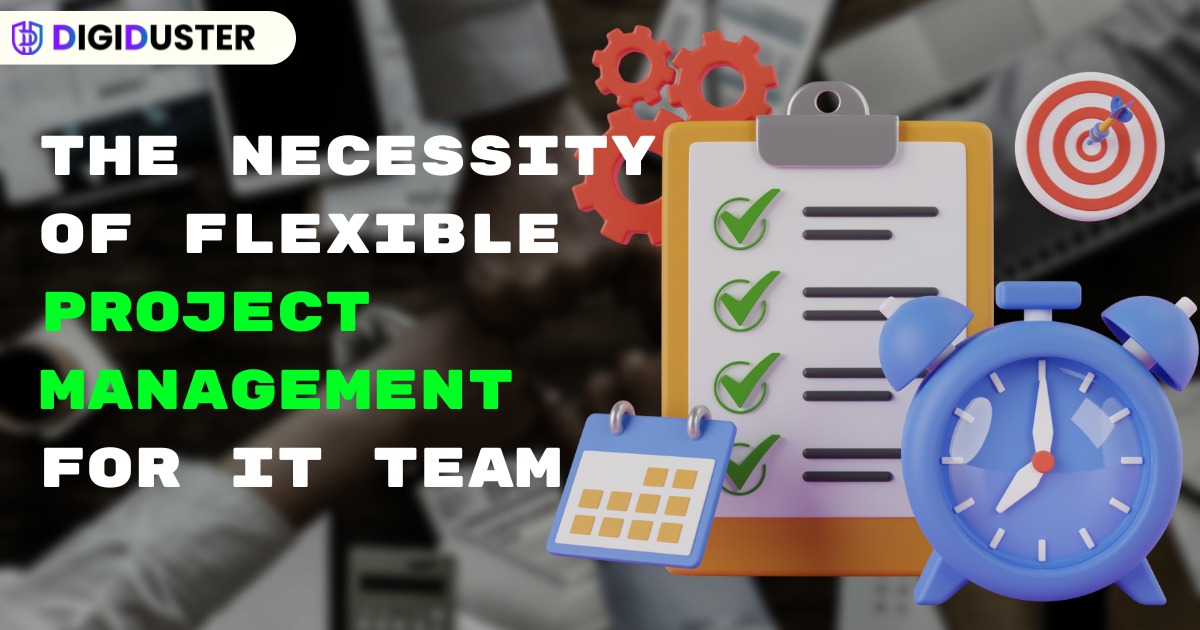Project management is inherently complex and multifaceted. It integrates diverse components such as planning, scheduling, and tracking to drive the continuous improvement of project outcomes.
However, embracing flexibility within the project management framework becomes essential to elevate team productivity and adapt to dynamic operational environments.
Understanding Project Management:
For many IT professionals, particularly developers and programmers, traditional project management often presents a steep learning curve. Most have limited experience working beyond IT silos, resulting in a gap in managing cross-functional projects.
This challenge underscores a prevalent scenario in today’s organizations, where IT departments frequently function as insular teams, distanced from broader business objectives.
The reality of resource constraints necessitates agile and flexible project management approaches, enabling swift responses to change. Major IT teams are increasingly adopting new operational paradigms to align more closely with evolving business needs and complexities inherent in modern applications.
Why Flexible Project Management is Crucial for IT Teams:
1. Anticipate Change:
Project managers must proactively embed flexibility into project timelines to accommodate mid-course adjustments. Identifying potential risks allows for the development of mitigation strategies that minimize disruptions to project execution.
Flexibility also facilitates parallel processing, enabling teams to address challenges without halting progress. Effective change management requires all stakeholders to clearly understand how modifications will be handled, enabling rapid re-engagement after adjustments are made.
2. Empower Team Members:
In scenarios where a single project manager oversees multiple initiatives, it is imperative to delegate decision-making authority within the team. Empowerment reduces bureaucracy and accelerates the decision-making process.
See also: How to Start a Career in Cyber Security Easily
All team members should comprehend their roles and responsibilities, fostering accountability and enhancing responsiveness to emerging issues early in the project lifecycle.
3. Segment Work into Manageable Chunks:
Decomposing work into smaller, manageable increments promotes agility. This iterative approach not only demonstrates efficient progress through tangible outputs but also allows for continuous validation and refinement based on feedback.
While this method is versatile across various projects, it aligns particularly well with Scrum methodologies, where the objective is to deliver increments to production after each sprint. Each component should be evaluated for optimization opportunities beyond mere compliance with established protocols.
4. Set and Review Expectations Regularly:
Conflicting expectations are a frequent pitfall that can derail project timelines. For instance, if a knowledge transfer initiative is in play, an engineer may anticipate hands-on sessions, while a project manager may expect comprehensive documentation.
Such discrepancies can lead to scope creep and additional workload. Therefore, it is crucial to surface assumptions early in the project and ensure alignment between team and customer expectations through well-documented agreements, whether through structured meetings or informal discussions.
Addressing the Challenges of Flexible Project Management:
IT teams may benefit greatly from flexible project management, including increased collaboration, risk management, and flexibility, but there are drawbacks as well. This approach’s fluidity and dynamic character might lead to complications that require close attention to guarantee its efficacy.
Teams must be ready to tackle these issues as IT projects develop if they want to fully utilize flexible project management. The main obstacles associated with this strategy will be examined in this essay, along with solutions.
1. Absence of Focus and Clear Direction:
The possibility of losing sight of the project’s overarching goals is one of the most frequent problems with flexible project management. The team may lose sight of the long-term goal in favour of concentrating on solving current issues and duties because of the inherent flexibility and frequent adjustments.
Solution:
IT teams must strike a balance between flexibility and strict strategic supervision to reduce this risk. To make sure that teams are still working toward the end goals even as they adjust to new information and input, regular goal-setting meetings and the maintenance of a clear project roadmap are crucial.
This may be facilitated by putting frameworks like Agile into practice, which emphasize frequent iterations and planning meetings like sprint reviews and retrospectives that help the team refocus on the project’s overarching objectives while allowing for flexibility.
2. Overcoming Change-Resistant Behavior:
Although not everyone is at ease with change, flexible project management necessitates an attitude that welcomes it. Some team members could object to frequent changes in the tasks, scope, or direction, especially if they are used to more conventional, organized project management techniques. This opposition might impede development and cause conflict within the team.
Solution:
Fostering a culture that is open to change is the first step towards successfully using flexible project management techniques. Effective communication and training are essential for assisting team members in realizing the advantages of flexibility.
Stakeholder support is also necessary. Building trust and lowering resistance may be achieved by including stakeholders in the decision-making process and making sure they get the value of flexibility.
3. Scope Creep:
One of the dangers of flexible project management is scope creep, which occurs when new needs or concepts are added over time and cause the project’s scope to grow out of control. Although flexibility makes it possible to include fresh perspectives, it can also result in the inclusion of features or activities that exceed the project’s budget and schedule.
Solution:
It is essential to create a well-defined scope at the beginning and evaluate modifications often with this baseline to avoid scope creep. Prioritization and the utilization of backlogs are two agile strategies that can assist in guaranteeing that any new features or activities are in line with the main objectives of the project.
To make sure that new requests are appropriately assessed and contextualized, teams should also place a high priority on ongoing engagement with stakeholders.
Conclusion:
Project management operates in an increasingly challenging landscape filled with perpetual demands, shifting priorities, and evolving job expectations. The optimal approach to navigate this complexity is through adaptability, particularly as cross-functional teams increasingly engage in project execution.
While there are varying perspectives on the implications of this shift, the discussions that arise can significantly influence how adaptable project management strategies impact productivity, resource allocation, and the duration required for external resource engagement.



